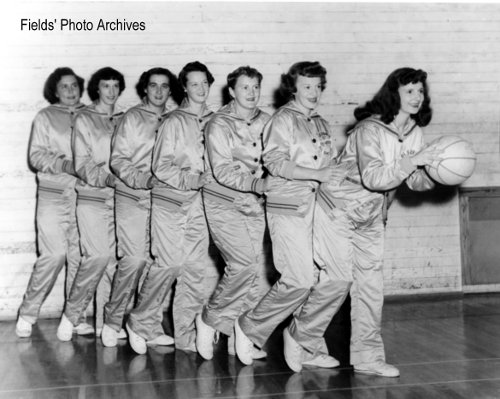Now this is a fabulous story of women’s liberation before it became a political movement. The All American Redheads was started by a man who had financial and entertainment foresight, C.M. “Ole” Olsen. “Ole” Olsen played for the basketball team “The Terrible Swedes” and apparently had some good ideas in his head about women’s basketball. He had previously tried to piece together a women’s basketball team but it never came to fruition, until he fell in with The All American Redheads. There were only two requirements to be on the team: the girls had to have red hair and be tall. One would hope that you also had to be a great player as well which seems evident by their many wins. Olsen began searching the country for All American women’s basketball players. He eventually found enough women to piece together two teams to tour the country.
The story goes that Olsen’s wife, Doyle, owned five beauty shops around Missouri and Arkansas and had some girls working for her that played basketball. Two of these girls were red heads. As a joke the entire team colored their hair red with henna. It was the gimmick that the women needed to be known and then with a foot on the court they wowed crowds with their talent.
Soon they became the talk of the town and later the country. They had talent and flair and have been compared to the Harlem Globetrotters. The women were coached by Wilbur “Wiggles” Surface. He coached them around the country and even into the Philippines, Canada, and Mexico. As the girls grew more talented and comfortable on the court Olsen began to add more crowd-pleasing and awe inspiring tricks.
In 1948 hired Orwell Moore to coach the western unit because they often had two teams playing at once. Moore would go on to buy the team a few years later. Coach Moore was often asked if the women played the games “straight.” He replied that “We would always play it straight in the beginning of games…and then we would add the entertainment. We would put on a display at halftime.”
The most phenomenal part of the amount of games these women won was that they only played men’s teams. I am sure this was a terrible blow as well as a surprise to the men they crushed on the court. Olsen, however, brought together some amazing talent who had outstanding scoring abilities. One of particular interest is Lorene “Butch” Moore. She scored an amazing 35, 426 points in 11 seasons. Also, during half time she was said to get on her knees and drop 25 free throws in a row. She would also dribble and bounce the ball off her head and into the hoop. She had awesome style and flair for the game of basketball. Other great players were Red Mason, Jolene Ammons, and Charlotte Adams.
The ladies, although talented in a sport that has largely been dominated by men throughout the years always were very fashion conscience. Their outfits, like their playing, had flair and class. Many of their uniforms were made of satin, very ladylike indeed.
Many to this day are curious as to how these women could beat a man’s basketball team. The idea is that the game had to be fixed otherwise there would be no way for a woman to overtake a man in any sport. Not true, according to Coach Moore, who said the trick was “to control the game” and “be excellent at blocking out.” He said that “they were better shooters than nowadays. We had to play our game.” And play their game they did. They knew how to play and the women played to win. Their won-lost record for the 1930’s and 1940’s is quoted as being 50%. That was quite a feat considering they only were competitive with men’s teams.
The All American Redheads were a popular phenomenon in a time when a woman in sports was not seen as appropriate. They were so popular that in 1996 women were still inquiring about being on the team even though they had been disbanded for 10 years. This team had and will have a lasting effect on women’s sports. They proved that competition and competitiveness was not only enjoyable and important to men but also to women.
|





